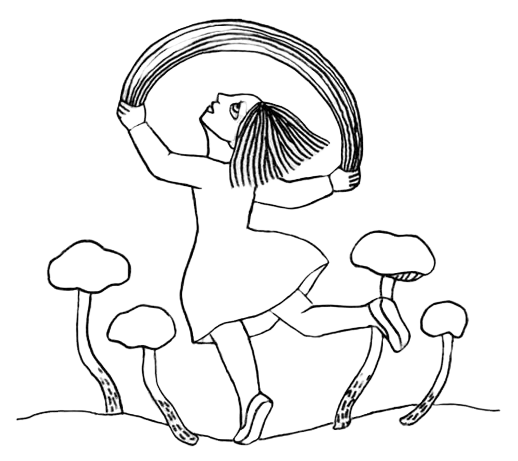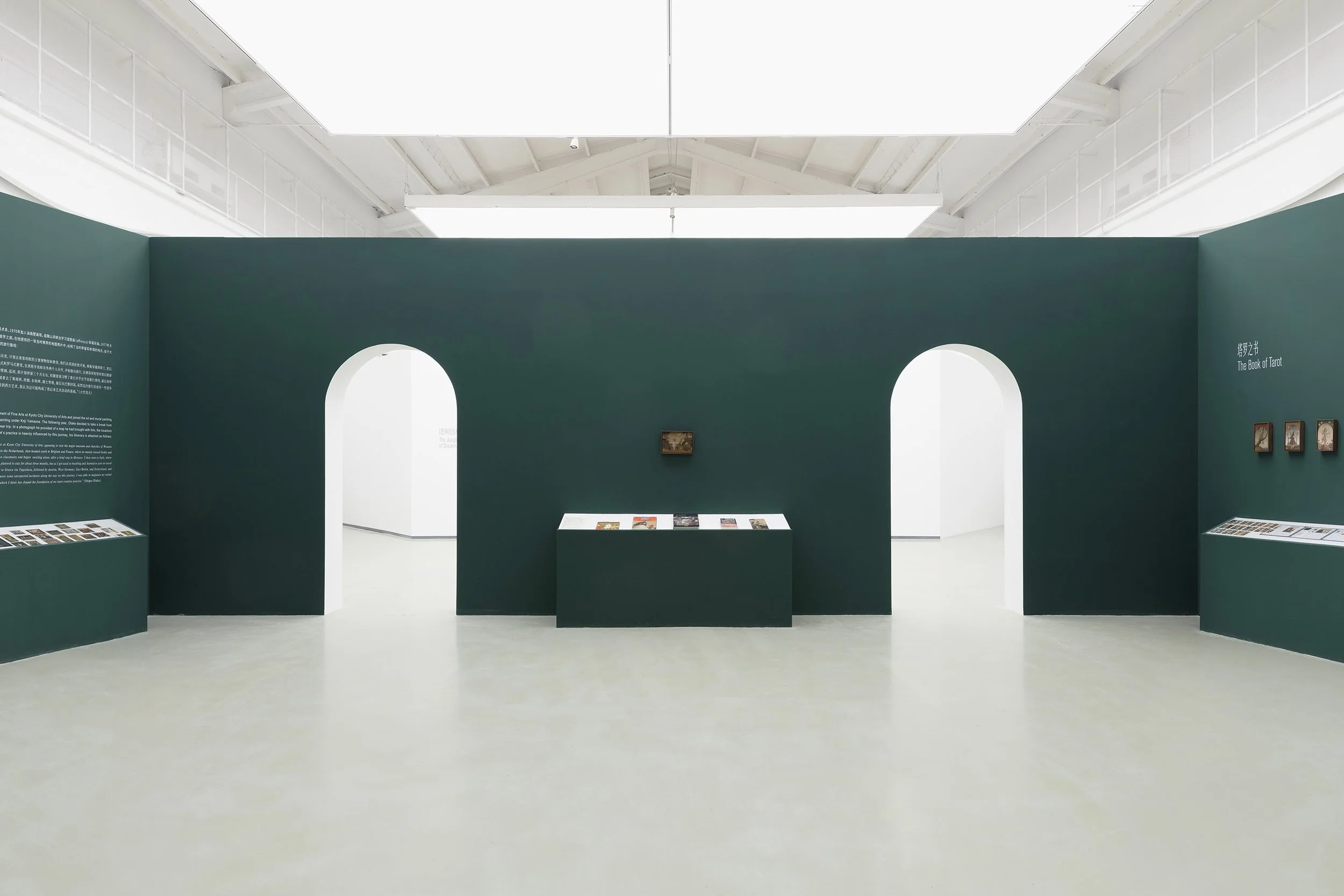Shigeo Otake: Fungitopia
4 March 2023 - 16 April 2023
Hive | Beijing
Shigeo Otake, born in Kobe, Japan, in 1955, witnessed the post-war Japanese economy from its revival to rapid growth and eventual collapse. He was also a participant in the global surrealism that developed in Japan in the 1960s that collided with the grotesque local culture. In the 1970s, Otake traveled to Europe to study Medieval and Renaissance religious frescoes. Since then, he has been exploring and discovering multiple species, especially fungi, in the rural areas of Kyoto, Japan. From the 1980s to the present day, he has been more closely involved with the Japanese publishing industry and the research community of Cordyceps than with the art community.
Consequently, despite his formal aesthetic education at Kyoto City University of Arts, his connection to a multi-species world has allowed him to wander beyond the divisions of art history over time. In a way, the state of his life is also a profile of his practice. Shigeo Otake creates an otherworld secluded from reality; in it, the various forms of the “inhabitants” were initially inspired by prehistoric lives, insects, and sea creatures. A cicada Cordyceps unearthed in 1985 from a shrine near his residence introduced Otake to the more bizarre world of Cordyceps from edible fungi. Cicadas, spiders and other host larvae infested by the fungus reveal themselves in human form and appear in turn in his works.
This exhibition focuses on Shigeo Otake’s “Journey to Europe” in 1977–78, narrating “The Jungle of Discernment” provided by European cultivation and the mythological structure shaped by the unique context of Japan as The Origin of Affect”, establishing the underlying logic of Otake’s practice in terms of style, representation and narrative. The exploration and research of multiple species have encouraged the artist to venture into a wilderness saturated with primordial symbolisms. The “accidental” discovery of fungi built on his previous research and prompted him to become a fungus hunter in the jungle. “The Changing Appearance of Cordyceps” metamorphoses the infested host larvae into human form in the paintings. In “The Birth of Fungal Generation”, Otake’s allegorical text echoes the elaborate and delicate images, transforming the religious narratives of the Middle Ages and the Renaissance into the reverberations of his practice.
Ⅰ. Journey to Europe
"I set out with two classmates from my fresco class at Kyoto City University of Arts, intending to visit the major museums and churches across Western Europe. We began our journey in London, took a boat to the Netherlands, and then traveled south to Belgium and France, where we primarily visited Gothic and Romanesque churches. In Spain, I parted ways with my two classmates and continued traveling alone. After a brief stop in Morocco, I went to Italy, where I focused on visiting Renaissance frescoes. Initially, I planned to stay for about three months, but as I grew accustomed to traveling and became more adept at managing my expenses, I extended my stay to around six months. I traveled to Greece via Yugoslavia, then visited Austria, West Germany, East Berlin, and Switzerland, before finally returning to Japan from Paris. Despite a few unexpected events during the trip, I was able to stay true to my goal of experiencing as much Western art as possible. This journey, I believe, laid the foundation for my later creative endeavors." (Shigeo Otake)
Ⅱ. Book of Tarot
Shigeo Otake's exploration of tarot cards was initially inspired by mystery writer John Dickson Carr's novel, The Eight of Swords, in which the Tarot was used as a prop throughout the story. Otake had no intention of studying divination, but the increasingly prolific fungus gathering in the western part of Kyoto prompted him to draw parallels between the eccentric and volatile exterior and the inner nature of fungi with the information on the tarot cards, rendering a more uncanny ambiance. For Otake, the tarot cards serve not only as a bridge linking the fungal realm with the human mind but also as a gateway for viewers to enter the wondrous and miraculous world of fungi.
Ⅲ. The Jungle of Discernment
In viewing Shigeo Otake’s work over a twenty-year period starting in the 1980s, stylistically, it is like entering a visual jungle made by Paolo Uccello, Giotto di Bondone, Sandro Botticelli, Giorgio de Chirico and others. For the artist, the high walls of humanism constructed by frescoes and sculptures attached to temple ruins, church sanctuaries, and royal palaces highlight a consistent sense of discernment: a balance of narrative, exploration of techniques, and focus on metaphysics. The intensification of symbolism in medieval and early Renaissance artworks created a seemingly rigid stylistic feature that could serve as an external framework for capturing the culture of Japanese monsters. Western styles provided a metaphorical and symbolic expression that serves as a genealogical paradigm for Otake’s construction of the otherworldly kingdoms.
Ⅳ. The Origin of Affect
Japan's long, narrow landscape, with its lush mountains and forests, has shaped and preserved a rich system of mystical figures. These include Princess Kaguya from The Tale of the Bamboo Cutter, Momotarō and Princess Gourd from folklore, the spirit-possessed tools known as tsukumogami, and the procession of Hyakki Yagyō . Shigeo Otake lives in the remote countryside, surrounded by cemeteries and shrines, creating an otherworld that is interconnected with various species yet withdrawn from reality. Like a hunter intimately familiar with his mountains and forests, the multi-species inhabitants of the real world, endowed with supernatural abilities, grow, flourish, coexist, and intertwine in his work, continuously sparking the potential of painting on canvas. The whimsical nature of Japanese mythology and the faint whispers of the jungle form the emotional foundation of Otake's world of painting.
Ⅴ. The Changing Appearance of Cordyceps
The spores and germinating ascospores of Cordyceps act like traps in the jungle, lying in wait for their hosts. When the right insects pass over the ground or beneath a leaf, the spores silently attach themselves to the insect's shell or epidermis. Over time, the fungus forms budding tubes that pierce the insect's exoskeleton, infesting the body, draining its energy, and taking control of its consciousness, turning the insect into a mere puppet and empty shell. The countless variations of fungal species and hosts, with their eerie, ghostly, and endless forms, surpass the excitement Shigeo Otake once found in the chimeras born from human imagination. In his work, Otake transforms the fungal hosts into human forms, preserving the distinctive shape of the fungal ascospores. His years of discovery and research on Cordyceps have provided lasting nourishment for his paintings.
Ⅵ. The Birth of Fungi Generation
From Traveling Fungi Fair History (1988-1993) to Fungal Generation (2004-2005), a complete narrative of the fungal world unfolds: a traveling mobile fungal garden suddenly visits a human town, and the people who visit it become infected with spores and begin to grow fungus. Humans struggle to find a cure, but they are powerless against the unstoppable spread of the infection. As human civilization reaches its end, people decide to unite their remaining consciousness and, after many attempts, finally merge with the fungus, giving rise to the "fungus human." What is profound about Fungal Generation is Shigeo Otake's use of a narrative method reminiscent of Dante's Inferno, encapsulating the metaphor of a post-human era through the survival and reproductive patterns of fungi. Just as Dante's Inferno fills the gap left by the Bible's lack of descriptions of the underworld, the continuous, complex, and intricate visual experience Otake reveals evokes a spiritual tension that resonates deeply.





































